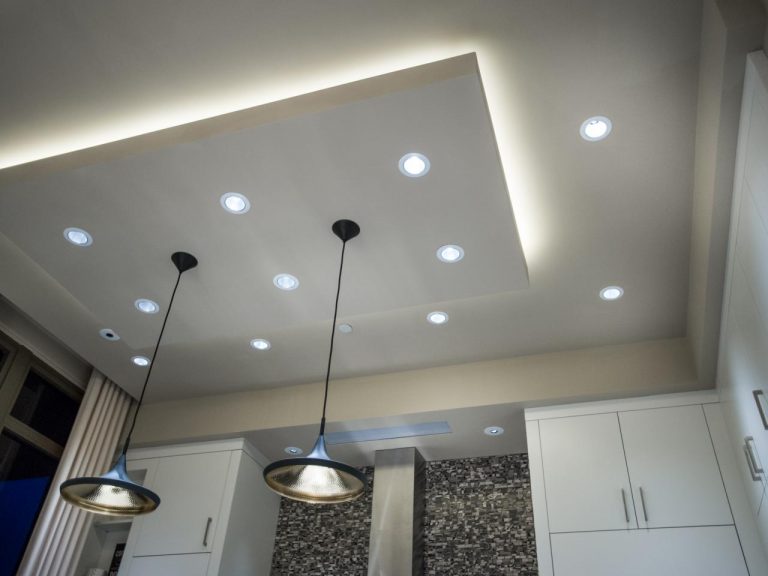What is IC Rated Recessed Lights? What are the benefits of using them over other types of recessed lights? What about their disadvantages? What type of lighting fixtures can you use with IC-rated recessed lights, and what type of light bulbs should be used? These are just a few questions that we will answer in this blog post. To find out, keep reading!
What is IC Rated Recessed Lights?
IC-rated recessed lights are recessed lighting fixtures that are designed to be installed in insulated ceilings. What does this mean? It means the ceiling has a layer of insulation between it and your home’s roofing material, which prevents condensation from forming on the underside of the roof deck. When condensation forms on the underside of a roof deck, it can lead to irreparable damage.
An IC-rated recessed light has a unique back can that allows it to breathe and pass moisture through the fixture’s body. What does this mean? It means the institution doesn’t trap moisture inside, which is what typically causes condensation.
How to Tell If Recessed Lighting Is IC Rated?
Look for the manufacturer’s name on the inner chamber of your light fixture. The letters “IC” usually appear in the model number of IC-rated fixtures, while those with a “NON-IC. The wattage of the light fixture and the maximum wattage can be found on the label. The maximum wattage isn’t a precise measure of how bright your light will be because many environmental factors influence the apparent brightness.
What Are the Benefits of Using Them Over Other Types of Recessed Lights?
- There are several benefits to using them over other types of recessed lights. In this section, you will know what the benefits of using them are.
- IC Rated Recessed Lights are certified to be energy efficient, and they offer many benefits.
- One significant advantage is that these lights can save you money on your energy bill. They are also easy to install even above the countertops, so you don’t have to hire a professional electrician for the job.
- You can find these lights in various styles, so you are sure to find what you need.
- Companies like to use IC Rated Recessed Lights because they are resistant to moisture and corrosion.
- Because of this, these lights can be used in bathrooms and kitchens without issues.
- You can use them both indoors and outdoors, so they are versatile enough to be used anywhere.
- They are also small so that they can fit into tight spaces.
What About Their Disadvantages?
There are some disadvantages to using these lights.
- It would help if you had a lot of experience with wiring and electrical systems to install them properly since beginners are not designed to install them properly.
- This means that it is not recommended to install them yourself if you are inexperienced.
- You also need to make sure they are installed at the proper depth.
- To get the most out of your lights, you need to ensure that they have been installed correctly. Otherwise, they might not be as energy-efficient as you thought, and it could cost you a lot of money on your energy bill.
What Type of Lighting Fixtures Can You Use With IC-Rated Recessed Lights?
The best type of lights to use with these recessed lights are LED and CFL. Because they don’t emit much heat, you can use them safely without worrying about fire hazards.
It is also important to get lights rated for wet conditions since you can install them in bathrooms and kitchens.
LED and CFL lights are both rated for wet conditions to be used with IC Rated Recessed Lights.
What Type of Light Bulbs Should Be Used?
You can use any light bulb with IC Rated Recessed Lights.
However, it is recommended that you use LED or CFL lights to get the most out of your recessed lighting fixtures.
LED and CFL bulbs are more energy-efficient than other lighting options, such as incandescent and halogen bulbs.
These particular types of light bulbs generate far less heat, so it is safer to use them in recessed lighting fixtures.
You also need to make sure that the lights you choose are rated for wet conditions if installed in bathrooms or kitchens.
This means that LED and CFL lights are especially ideal because they emit a lot less heat than other types of lights.
Conclusion
In conclusion, these lights offer several benefits, and they can be used in various applications.
While there are some disadvantages to using them, such as that you need to have experience with electrical work or hire an electrician if you don’t, they are worth it for their energy efficiency and durability.
They also have a long lifespan, so they don’t need to be replaced as often as other lights might.
However, if you are inexperienced with electrical work, you would instead hire a qualified electrician to install them. It is recommended that you use LED and CFL lighting options because they are energy efficient and emit very little heat.
It is also essential to ensure that you get lights rated for wet conditions if you want to install them in bathrooms or kitchens since they don’t generate much heat.
Since LED and CFL bulbs are especially ideal because of how energy efficient, low wattage, and low heat they emit, it is recommended that you use these types of light bulbs.

